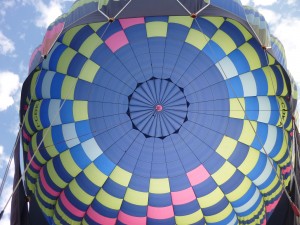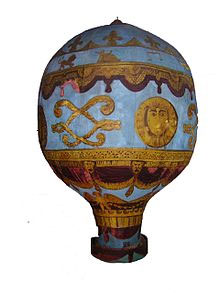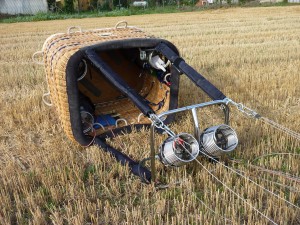COMPONENTS OF A BALLOON
A modern Hot Air Ballons consists of three basic components:
1) An envelope or balloon

A Hot Air Balloon is constituted by a large envelope made from a monolayer of fabric panels (ripstop nylon) sewn to each other. This material is resistant to temperatures in excess of 220 ° Celsius / 428° Farenheit. The shape and volume of the balloon can vary: the size of the balloon is a function of the load that you need to carry as well as the ambient temperature. To compensate for the additional weight and higher operating temperatures, the balloon size is increased. The models used to carry passengers in flight have a greater volume (approx 5000 cubic meters) than the balloons used for advertising (2-3000 cubic meters)
The balloon and the basket are coupled together by stainless steel cables and stainless steel karabiners that have an average tensile strength of 2.5 tons each. The basket is made of wicker and is of rectangular or square shape. The balloon has an opening in the lower part also called the ‘mouth’. The burner is fixed on the basket, immediately below the mouth. This instrument is able to create flames which are six meters in length within the balloon, raising the air temperature that fills its balloon. The fuel used to power the burner is propane gas, which is stored in special cylinders that are fixed and strapped to the inside of the basket. The heated air inside the balloon makes it lighter than the surrounding air which in turn generates a lifting force allowing the balloon to rise in flight in conjunction to the principle of archimede.
Now… only 6 small steps that separate you from the fulfillment of your dream to fly …
Before a flight is made, the preparation of the equipment will normally take 20-40 minuted depending on the size of the balloon used. You first need to find an appropriate field for takeoff: minimum required surface is 50m x 50m, with no obstacles, and if possible made of soft grass.
- Assembly of the basket: all necessary equipment is transported in a trailer or van. The burner is installed on the basket on 4 flexi poles (structures that give flexibility to burner/basket assembly). The safety of basket / burner rigging is guaranteed by stainless steel cables and karabiners that connect the basket and burner frame. The propane cylinders are accurately fixed inside of the basket and are subsequently connected to the burner, whose operation is controlled during the pre-inflation check. At this point the set basket-burner is ready to be connected to the envelope.
- Preparation of the envelope: Inside the trailer is placed the bag containing the envelope carefully folded. Part of the envelope is extracted from the bag and attached by karabiners to the basket. Once the connection is properly made, the envelope is totally removed from his bag and laid down on the surface.
- Cold inflation of the balloon: Cold air is blown inside the balloon with the aid o fan engine driven fun.Two employees ground crew members, keep the mouth of the balloon opened, allowing the fan to blow the cold air inside. The balloon begins to assume its proper size and inflates.
- Hot Inflation and Takeoff: The pilot is now ready to warm up the air inside the envelope through the use of the burner. The balloons begins to take its final shape, and once it is in vertical position, the passengers are asked to climb on board. After a briefing on what are the security procedures and how passengers should behave, the flight can begin
- The flight: The light wind drives the balloon and its crew toward a destination unknown. The feeling you will experience is unforgettable;he silence that surrounds you, will transmit joy of the most true and realistic feeling of flying
- Landing: Even if the landing site is always different, the pilot will choose an area accessible to the retrieving crew so that the equipment and pilot + passengers can be joined. A few minutes before landing, the pilot will provide passengers with the necessary instructions for completion of the flight. The balloon in a very natural and light way will approach and land toching the ground. After landing and after arrival, passengers can get off the field and put the feet on the ground nowing that they had left their hearts and their minds up there, much higher.
THE HISTORY OF BALLOONS:
The balloon is the most common type of balloon: it belongs to the category of balloons, aerial vehicles that use that gas to fly.At the base of the balloon flight is the “Archimedes Principle”: the principle that a body immersed in a fluid receives an upward thrust equal to the weight of the volume of fluid displaced. In this case the fluid is all the air. The gas which fills the balloon is lighter than the surrounding air and this generates an upward Lift force. The fluid that fills the ball is constituted by the gases generated by combustion of propane. Propane is the fuel used to power the burner of the balloon.
History Of Balloons:
Since the third century after Christ, are documented in the history of ancient China to use paper balloons, known as “Kongming lanterns” to military reports. Although therefore the use of balloons dated back to many centuries ago, the first documented flight crew is dated October 19, 1783, and took place in Paris.
The Montgolfier brothers, Joseph-Michel and Jacques-Etienne, and they realized that the ‘hot air’ was lighter than ‘cold air’, so this principle could be exploited to raise something in the air. In October there was the first flight with a balloon tied to the ground, while the first free flight was held on 19 November of the same anno.Inside the flask contained only three cubic meters of hot air, but then the volume was increased and this allowed during the experiments to reach ever higher odds: with 800 cubic meters of hot air is able to touch the 1200 feet of altitude (about 350m).
During these experiments, there were continuous improvements that concluded with a test that took place in public on June 4. The balloon was filled with 900 cubic meters of hot air and was left free to fly: the balloon reached an altitude of well 30000 feet (about 10,000 m), before beginning to descend due to the air inside the balloon began to cool
Jacques-Etienne was convinced of the goodness of his mind and wanted to go further: it was time to do a test with the “passengers”. Clearly it was too dangerous to take a human being and put it on this flying machine, so the first crew that flew on September 19 at Versailles was composed of a duck, a rooster and a sheep.
The three animals were laid in a basket attached to the balloon: the flight lasted around three minutes, and once again the balloon touched the ground, the three animals were still alive and in good condition. This was the ultimate proof that it was possible to fly without any risk.
Now the time was ripe for the first flight carrying people. As the first man to set foot on the aircraft was chosen, Pilatre de Rosier, a scientist from the very beginning was fascinated by the flying machine of Montgolfier.
Per avere una migliore distribuzione dei pesi durante il volo un altro passeggero partecipò al volo. La cesta attaccata al pallone era un’ulteriore evoluzione di quella in cui avevano volato gli animali: suddivisa in tre parti; negli scomparti laterali vi erano gli alloggiamenti per i passeggeri, metre in quella centrale era posizionato un fuoco di paglia (l’antecedente dell’odierno bruciatore).
With this configuration, the two passengers were able to feed the fire and therefore adjust the altitude of the balloon. The flight took place on September 21, 1783, a date that made history because it sanctioned the first flight of a human piloted balloon. The experiment was a resounding success. The balloon, thanks to the skill of the pilots, remained airborne for almost half an hour and reached an altitude of 3000 feet (about 1000m). Man was able to fly.
Further developments were made that day, and this event had in fact started a race to see who could make the longest flight, or to reach the highest altitude. Eventually there was the introduction of the hydrogen balloons; balloons containing 23000 cubic meters of gas. Despite this truly revolutionary invention, it was not long before you reached the decline of the balloon, which was superseded by the advent of the airship.
The balloons were completely abandoned until the second half of the twentieth century, more precisely, until 1960, when the American Ed Yost gave birth to the new generation of balloons as we know them today.
The advent of new materials and especially of propane burners gave new life to the balloons. From that day there were no further progress as regards the form of balloons, but certainly the new technologies and new materials have led to more and better performing balls and burners and safe.
